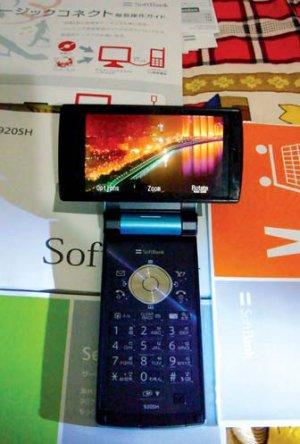Technology: I Want My 1seg TV
 By Robert Sanzalone
By Robert Sanzalone
If Japanese consumers don’t even really want TV on their cellphones, why has it been such a hit?
Life in Japan generally produces many opportunities when there is downtime. Riding on trains and sitting in traffic create a situation where one wonders if there could be some usefulness to this gap in mental stimulation. So it is with little surprise this nation has not only excelled at producing ingenious little televisions, but the technology to deliver broadcast content as well. One-seg has been one of those Japanese technology success stories.
The story of 1seg is not a long one. In a nutshell, it can be described as a piece of technology that allows mobile devices such as cellular phones, global positioning system (GPS) devices, laptops, PDAs and of course, mini-televisions themselves, to be able to receive regular high definition (HD) broadcast signals. The challenge, of course, has been space and strength. Analog broadcasts have traditionally taken a significant amount of resources to be picked up by any device. The answer has come with the “segmenting” of digital broadcasts. Since HD signals are sent out with 13 segments, one segment could be reserved for a special signal to be picked up by properly equipped devices—thus the birth of the term “1seg.”
 One-seg TV technology has become a major part of Japan’s move to go fully digital.
One-seg TV technology has become a major part of Japan’s move to go fully digital.
The first devices equipped to catch this special signal began appearing in 2005. KDDI’s au was the first to sell cell phones advertising the ability to watch television using this new technology and competitors such as Docomo were not far behind. By April 1, 2006, the technology was “officially” launched in Japan and most manufacturers were onboard and preparing to include 1seg in many of their new products.
Interestingly enough, 1seg was not universally accepted at first. DIMSDRIVE Research conducted a survey asking Japanese consumers what features on their already overly complex cell phones were not needed. Television frequently appeared as one of the top 10 features not wanted. Complaints also escalated regarding poor quality or lack of reception (especially on subway lines or tunnels), channels switching to other frequencies mid-voyage (especially on the shinkansen) and faster drainage of the device’s battery.
Undaunted by these complaints, manufacturers continued their efforts to include 1seg technology in more devices and Japanese consumers began to not only embrace it, but take its existence for granted. By late 2007, the Japan Electronics and Information Technology Industries Association reported that over 3 million cell phones were shipped with 1seg technology per month—accounting for over 63 percent of all shipped phones. In fact, Japanese consumers now appear to have an expectation that 1seg be included on new, advanced mobile devices. The recent introduction of Apple’s iPhone in July 2008 saw a lot of excitement for its launch, but experienced lukewarm sales of only 200,000 units in the following two months. One of top reasons quoted for this has been the iPhone’s lack of 1seg technology.
Regardless of whether Apple or any other company decides to include 1seg in their products in the future, the technology itself continues to roll ahead. In late 2007, Brazil began HD broadcasting with 1seg to a few select cities. Also over the past year, 1seg has been found on PSP, Nintendo DS and even Sanrio, makers of the ever-adorable Hello Kitty, released a 1seg mini-television in the shape of the feline character.
Japan has made some smart moves as it progresses towards being totally digital by July 24, 2011 and 1seg has been a major part of the planning. It’s interesting to see how Japanese consumers have willingly become part of this change, not in the name of progress, but simply because they wanted a little entertainment and news while taking the train home.
Robert Sanzalone is a technology writer, presenter and social media consultant based in Nagoya, Japan. Visit his website at www.pacificIT.ca.





